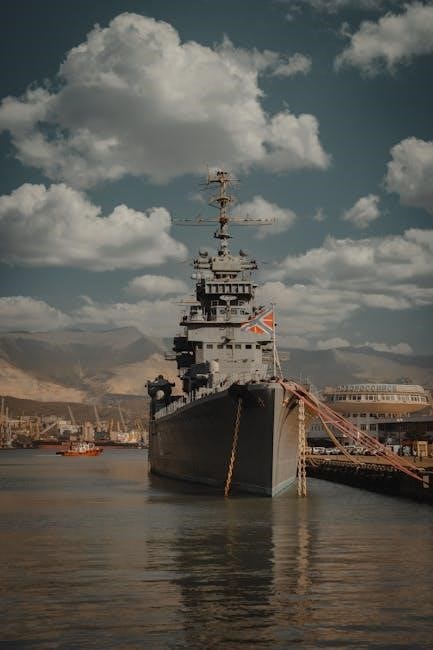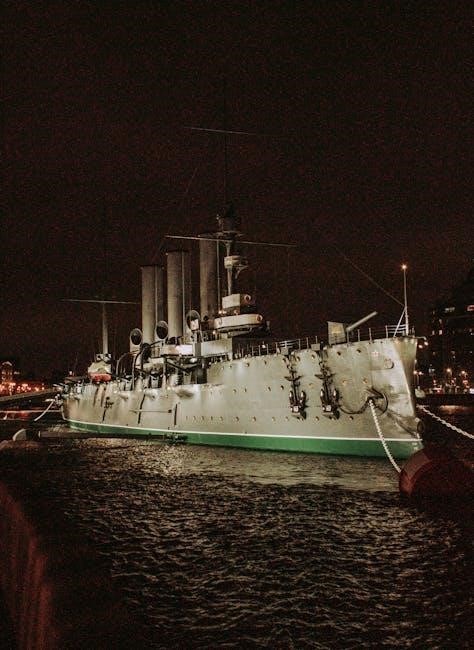russian fleets pdf
The Russian Navy, a powerful maritime force, operates four fleets and one flotilla, each tasked with strategic roles. Its history traces back to Soviet traditions, emphasizing nuclear deterrence and littoral defense. Recent operations highlight its adaptability, with a focus on sea denial and global deployments, despite resource constraints and sanctions.

Structure of the Russian Navy
The Russian Navy is organized into four fleets (Northern, Pacific, Baltic, Black Sea) and one flotilla (Caspian), each assigned to specific maritime regions. This structure ensures strategic coverage, focusing on sea denial, nuclear deterrence, and littoral defense, while addressing resource constraints and limited expeditionary capabilities.
2.1. Northern Fleet
The Northern Fleet is the most powerful and strategically significant component of the Russian Navy, headquartered in Severomorsk. It plays a crucial role in Russia’s nuclear deterrence, with its submarine force, including Delta IV and Borei-class ballistic missile submarines, patrolling the Barents and Norwegian Seas. These submarines are central to Russia’s strategic nuclear triad, ensuring the nation’s ability to retaliate in the event of a nuclear attack.
The Northern Fleet also includes a variety of surface combatants, such as the nuclear-powered cruiser Peter the Great, destroyers, and smaller warships. These vessels are tasked with protecting Russian territorial waters, ensuring access to the Arctic region, and conducting long-range deployments. The fleet has been increasingly active in recent years, participating in exercises that demonstrate its operational readiness and capability to project power.
In addition to its military role, the Northern Fleet is a symbol of Russian prestige and influence in the Arctic. As global interest in the region grows, the fleet has been instrumental in asserting Russian claims to Arctic territories and resources. Its operations are closely tied to Russia’s broader geopolitical objectives, including countering NATO’s presence in the North Atlantic.
Recent years have seen the Northern Fleet modernize its capabilities, with new ships and submarines entering service. This modernization effort reflects Russia’s commitment to maintaining a strong naval presence in the region. The fleet’s activities are closely monitored by Western nations, given their strategic implications for global security and the balance of power in the Arctic.
The Northern Fleet’s role extends beyond defense; it also supports scientific and exploratory missions in the Arctic, underlining Russia’s ambition to dominate this increasingly important region. Its combination of nuclear deterrence, conventional power, and strategic reach makes it a cornerstone of Russia’s naval strategy.

2.2. Pacific Fleet
The Russian Pacific Fleet, headquartered in Vladivostok, is one of the largest and most strategically significant naval forces in the Asia-Pacific region. It operates across a vast area, including the Pacific Ocean and parts of the Indian Ocean, making it the fleet with the largest operational area of responsibility. The Pacific Fleet is composed of a diverse array of ships, submarines, and aircraft, designed to ensure regional security and project power beyond Russia’s borders.
The fleet includes Delta III and Borei-class ballistic missile submarines, which play a critical role in Russia’s nuclear deterrence strategy. Additionally, it boasts a formidable surface fleet, featuring destroyers, corvettes, and smaller combat vessels. These assets enable the Pacific Fleet to conduct a range of missions, from littoral defense to long-range deployments, showcasing its versatility and operational reach.
The Pacific Fleet has been increasingly active in recent years, participating in joint exercises with allied nations and demonstrating its capabilities through naval drills. Its strategic importance is further underscored by its role in safeguarding Russia’s eastern borders and ensuring access to key maritime trade routes. The fleet’s modernization efforts, including the introduction of advanced frigates and submarines, highlight Russia’s commitment to maintaining a robust naval presence in the Pacific.
Overall, the Russian Pacific Fleet is a cornerstone of the nation’s naval power, combining strategic deterrence with operational flexibility to address both regional and global challenges; Its activities reflect Russia’s ambition to remain a major player in the Asia-Pacific region’s security landscape.
2.3. Baltic Fleet
The Russian Baltic Fleet, headquartered in Kaliningrad, is a key component of Russia’s naval forces in the Baltic Sea region. Established in 1656, it is one of the oldest fleets in the Russian Navy, with a rich history and strategic importance. The fleet operates in the confined waters of the Baltic Sea, focusing on littoral defense and regional security. Its primary responsibilities include protecting Russia’s western coastal areas and ensuring access to vital maritime trade routes.
The Baltic Fleet is composed of a mix of surface ships, submarines, and coastal defense units. Its fleet includes corvettes, patrol boats, and amphibious assault ships, which are well-suited for operations in the shallow waters of the Baltic Sea. The fleet also operates several Kilo-class submarines, enhancing its underwater capabilities. Air support is provided by naval aviation units, including helicopters and fighter jets, which play a crucial role in surveillance and defense.
Recent years have seen the Baltic Fleet engage in numerous exercises and drills, demonstrating its readiness to defend Russia’s interests in the region. These operations often involve interoperability with other Russian military branches, showcasing the fleet’s ability to conduct coordinated actions. The fleet’s strategic location in Kaliningrad, a Russian exclave, further underscores its importance in maintaining a strong military presence in the Baltic region.
Despite its focus on regional security, the Baltic Fleet remains a vital part of Russia’s broader naval strategy, contributing to the country’s ability to project power and safeguard its maritime interests. Its activities are closely monitored by neighboring countries and NATO, reflecting its significance in the region’s geopolitical dynamics.
The Russian Black Sea Fleet, stationed primarily in Sevastopol, Crimea, is a cornerstone of Russia’s naval presence in the Black Sea and Mediterranean regions. Established in 1783, the fleet has a storied history, playing pivotal roles in numerous conflicts, including the Crimean War and World War II. Its strategic importance lies in safeguarding Russia’s access to warm-water ports and projecting power in the Black Sea basin. The fleet’s composition includes a mix of surface combatants, amphibious ships, submarines, and support vessels. Notable assets include the Slava-class cruiser Moskva, which served as the fleet’s flagship until its loss in 2022, and Kilo-class diesel-electric submarines. The fleet also operates several smaller corvettes and patrol boats, ideal for coastal defense and rapid response missions. Recent years have seen the Black Sea Fleet involved in heightened tensions, particularly following Russia’s annexation of Crimea in 2014. The fleet has been instrumental in supporting Russian operations in Ukraine, including the blockade of Ukrainian ports and the protection of maritime supply lines. Its activities have also extended into the Mediterranean, where it conducts periodic deployments to bolster Russia’s influence in the region. Despite facing challenges such as aging equipment and international sanctions, the Black Sea Fleet remains a potent force, capable of exerting significant influence in its operational area. Its strategic location and historical significance make it a critical component of Russia’s naval strategy, ensuring the country’s continued presence in the Black Sea and beyond. The Caspian Flotilla is the smallest but strategically significant component of the Russian Navy, operating in the Caspian Sea. Headquartered in Astrakhan, the flotilla is tasked with ensuring Russia’s maritime security in the region and supporting operations in the Caspian littoral. Its primary responsibilities include monitoring the Caspian Sea borders, combating illegal activities, and providing naval support for regional security missions. The flotilla comprises a mix of small surface ships, amphibious vessels, and missile boats, optimized for shallow-water operations. Key assets include the Buyan-M-class corvettes, which are equipped with Kalibr-NK cruise missiles, enabling long-range strikes. These vessels have been used in operations against terrorist targets in Syria, demonstrating the flotilla’s capability to project power beyond its immediate operational area. The Caspian Flotilla also plays a critical role in supporting Russia’s ground forces in the region. Its amphibious ships can deploy marines and equipment for coastal assaults or humanitarian missions. Additionally, the flotilla collaborates with other Russian fleets during joint exercises, enhancing interoperability and readiness for multi-theater operations. Despite its limited size, the Caspian Flotilla is a vital instrument of Russian power in the Caspian region, ensuring access to energy-rich areas and maintaining stability in a geopolitically sensitive zone. Its versatility and strategic location make it an essential part of Russia’s naval strategy, capable of addressing a wide range of maritime and regional challenges. The Russian Navy plays a critical role in national defense, focusing on sea denial, nuclear deterrence, and global power projection. Recent exercises highlight its operational readiness, with deployments across the Atlantic, Pacific, and Indian Oceans. The fleet also supports regional security missions, showcasing its versatility and strategic importance in safeguarding Russian interests worldwide. The Russian Navy’s primary strategic objectives include maintaining sea denial capabilities and ensuring nuclear deterrence. Sea denial involves preventing adversaries from dominating maritime areas critical to Russian interests. This is achieved through a combination of surface ships, submarines, and shore-based missile systems. The Northern Fleet plays a pivotal role in this strategy, as it is home to the majority of Russia’s nuclear-powered ballistic missile submarines (SSBNs), which form the backbone of the country’s naval nuclear deterrent. These SSBNs, armed with intercontinental ballistic missiles, are capable of conducting second-strike operations, ensuring Russia’s ability to retaliate in the event of a nuclear attack. The strategic submarines operate under the protection of the Northern Fleet’s anti-submarine forces and air defense systems, which work to maintain a secure operational environment in the Arctic and North Atlantic regions. By focusing on sea denial and nuclear deterrence, the Russian Navy ensures that its maritime capabilities remain a credible threat to potential aggressors, safeguarding national security and maintaining the balance of power in key strategic areas. This dual role underscores the navy’s importance as both a conventional and strategic force, capable of addressing a wide range of threats and challenges in the modern maritime environment. The Russian Navy has recently conducted extensive exercises involving multiple fleets, showcasing its operational readiness and strategic reach. Exercises have included joint maneuvers by the Northern, Pacific, and Baltic Fleets, with a focus on interoperability and combat readiness. These drills often involve amphibious landings, anti-submarine warfare, and missile defense simulations, highlighting Russia’s ability to project power across multiple maritime theaters. Notably, the Pacific Fleet has been particularly active, with deployments to the Indian Ocean and the Atlantic. Russian warships have visited ports in Cuba and conducted exercises in the Caribbean, signaling Moscow’s intent to maintain a global naval presence. These deployments are part of broader efforts to demonstrate Russia’s ability to operate far from its home waters, challenging the dominance of other naval powers. Recent operations have also emphasized the integration of advanced weaponry and technology. For instance, the Northern Fleet’s nuclear-powered cruiser Peter the Great and destroyer Admiral Chabanenko have undertaken long-range missions, underscoring Russia’s commitment to maintaining a robust naval deterrent. Such activities reflect the navy’s strategic priorities, blending traditional power projection with modern capabilities to address emerging security challenges. These exercises and deployments serve as a testament to the Russian Navy’s enduring relevance on the global stage, even as it navigates resource constraints and international sanctions. By maintaining an active presence in key maritime regions, Russia seeks to reinforce its geopolitical influence and secure its interests in an increasingly competitive international environment. The Russian Navy places significant emphasis on littoral defense, focusing on protecting its coastal territories and maritime borders. This strategy involves deploying advanced missile systems, submarines, and smaller surface vessels to deny adversaries access to Russia’s coastal regions. The Bal and Bastion coastal missile systems, capable of engaging surface and airborne targets, are key components of this defense framework. The Navy’s littoral capabilities are further enhanced by its fleet of corvettes and diesel-electric submarines, which excel in shallow waters. These platforms are equipped with anti-ship missiles, torpedoes, and mines, enabling them to conduct asymmetric warfare and defend against larger naval forces. Recent upgrades to these vessels have improved their stealth and firepower, making them formidable assets in coastal defense scenarios. Russia has also strengthened its littoral defense by establishing forward bases in strategic locations, such as Tartus in Syria and Sevastopol in Crimea. These bases provide staging grounds for naval and land-based systems, ensuring rapid response to threats in critical regions. Additionally, the integration of drones and electronic warfare systems into littoral defense networks has further bolstered the Navy’s ability to monitor and control its coastal domains. Despite resource constraints, the Russian Navy’s focus on littoral defense ensures it can effectively safeguard its maritime borders and project power in nearby seas, such as the Baltic, Black Sea, and Caspian regions. This approach aligns with its broader strategy of leveraging niche capabilities to counter larger, more resource-intensive naval forces. Russia employs shadow fleets to bypass international sanctions, enabling the export of oil and petroleum products. These fleets operate covertly, often using aging vessels to evade detection. Despite EU/G7 price caps, Russia adapts by acquiring old tankers, ensuring its energy exports continue to flow, undermining Western sanctions’ effectiveness. Russia’s shadow fleets are composed of a mix of aging tankers and cargo vessels, often acquired through shell companies or third-party registrars. These ships, many over 20 years old, operate covertly to transport Russian oil and petroleum products, evading Western sanctions. Their activities are obscured by the use of flags of convenience, such as Panama or Liberia, and complex ownership structures. Operations involve routing shipments through intermediary ports in countries with weaker enforcement of sanctions. For instance, oil is sometimes transferred between ships at sea, a practice known as ship-to-ship transfer, to disguise its origin. This tactic allows Russian exports to reach global markets while bypassing restrictions imposed by the EU, G7, and other entities. Western nations have identified over 100 vessels linked to Russia’s shadow fleet, with some ships repeatedly changing names and registries to avoid detection. Despite these efforts, international sanctions and price caps on Russian oil have forced the fleet to adapt, relying on older, less efficient vessels. This has led to increased maintenance challenges and operational risks. Efforts to curb the shadow fleet’s activities include blacklisting suspect vessels and targeting insurance and financing mechanisms. However, Russia continues to find loopholes, underscoring the resilience of its sanctions-evasion strategies. The shadow fleet remains a critical tool for maintaining Russia’s energy exports, enabling the country to sustain its economy despite international pressure. International sanctions imposed on Russia have significantly impacted its maritime operations, particularly its ability to export energy resources. The EU and G7 nations introduced a price cap on Russian oil, effectively limiting its profitability and access to global markets. These measures have forced Russia to rely heavily on its shadow fleet to circumvent restrictions, using tankers operating under obscure registries to transport oil and petroleum products. The sanctions have also disrupted Russia’s access to critical maritime services, including insurance, financing, and ship maintenance. This has led to increased operational costs and challenges in sustaining its naval capabilities. Additionally, the restrictions have constrained the modernization of Russia’s fleet, as access to advanced technology and components has been severely curtailed. The EU’s ban on providing maritime services to Russian-owned vessels has further compounded these challenges. This has forced Russia to seek alternative solutions, such as acquiring older, less efficient ships and operating them under flags of convenience. Despite these efforts, the sanctions have eroded Russia’s ability to project naval power and maintain its energy exports at pre-sanction levels. Overall, the sanctions have imposed significant economic and operational pressures on Russia’s maritime sector, compelling it to adapt through covert operations and shadow fleets. These measures have, however, only partially mitigated the broader impact of the restrictions, highlighting the resilience of Russia’s sanctions-evasion strategies while underscoring their limitations. The long-term sustainability of these workarounds remains uncertain. Russia has implemented various countermeasures to mitigate the effects of sanctions on its maritime operations. One key strategy has been the expansion of its shadow fleet, which includes tankers and vessels operating under obscure registries to evade detection. These ships, often acquired from third-party owners, enable Russia to continue exporting oil and petroleum products while avoiding direct links to sanctioned entities. Another adaptation involves reflagging vessels under friendly or neutral countries’ flags. This tactic allows Russian-owned ships to operate more freely in international waters, bypassing restrictions imposed by Western nations. Additionally, Russia has increased its reliance on domestic shipbuilding and maintenance capabilities, reducing dependence on foreign technologies and services. Financial countermeasures have also been employed, such as using alternative payment systems and cryptocurrencies to facilitate transactions for energy exports. These methods help circumvent restrictions on traditional banking channels. Furthermore, Russia has strengthened ties with non-aligned nations, securing logistical support and port access for its shadow fleet operations. Despite these efforts, the effectiveness of these countermeasures is continually challenged by evolving sanctions and increased international scrutiny. The cat-and-mouse dynamic between sanctions enforcement and evasion strategies remains a critical aspect of Russia’s maritime operations, with both sides adapting to maintain their respective advantages.2.4. Black Sea Fleet
2.5. Caspian Flotilla

Strategic Role and Operations
3.1. Sea Denial and Nuclear Deterrence
3.2. Recent Naval Exercises and Deployments
3.3. Littoral Defense Capabilities

Shadow Fleets and Sanctions Evasion

4.1. Composition and Operations of Shadow Fleets
4.2. Impact of International Sanctions

4.3. Countermeasures and Adaptations